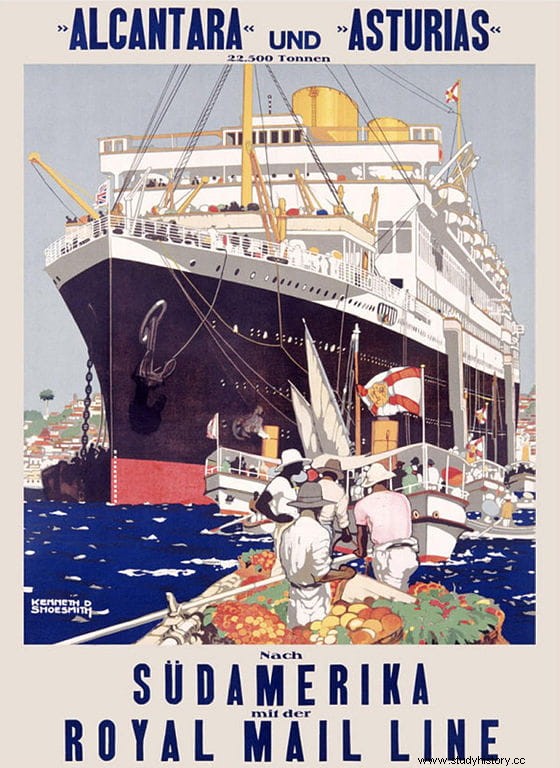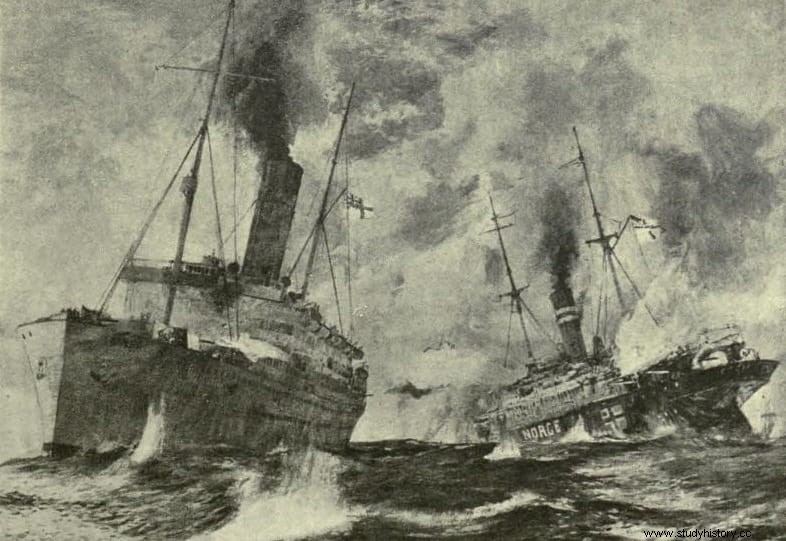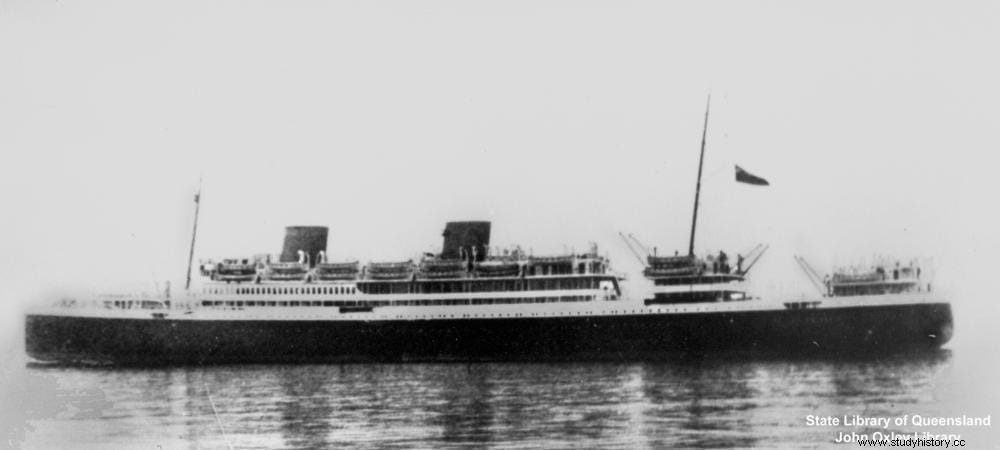Before James Cameron made it big with Titanic , there were other films that dealt with the subject. One of them was The last night of the Titanic (A night to remember ), the biggest-budget British production to date, directed by Roy Ward Baker in 1958.
To show the famous ocean liner on the screen, real images of him were used, but scenes were also shot on a retired ship that was being broken up at the Faslane naval base. What will leave more than one amazed is the name of said ship, since, despite her nationality, she was called RMS Asturias .
Better yet, the Asturias it was just one of a series of six units built by the Royal Mail Steam Packet Company and baptized with Spanish place names beginning with A (A-Series, they were designated), so in its fleet there was also a RMS Aragon , a RMS Alcantara , an RMS Arlanza and a RMS Almanzora , all of them put into service in the first quarter of the 20th century and some, by the way, before the Titanic itself. (which belonged to another shipping company, the White Star Line). To them should be added others such as the Ebro , the Douro , the Tajo , the Catherine , the Orotava , the Segura , the Alcalá , the Orduña … not counting those that made reference to Latin America.

The Royal Mail Steam Packet Company had a history. It was founded in 1839 by James MacQueen, a Scotsman born in 1778 who had been the administrator of a sugar estate on the island of Granada and had the idea of promoting the creation of a company that would improve communications between the Caribbean and the metropolis, at a time in which the American territories boiled with independence desires. MacQueen, uneducated but who would become a famous geographer, was also a staunch supporter of slavery and British imperialism (in fact, another creation of his three years earlier had been the Colonial Bank, a banking entity based in the Indies). Westerners) and thought that a naval line with Great Britain would prevent uprisings in overseas territories.
He thus obtained a royal charter (a kind of patent) and, with the motto Per Mare Ubique (Everywhere by sea), the company was growing under government protection. The contract called for a fleet of fourteen ships and, in effect, that number was put into service. They were called Thames , Medway, Trent, Isis, Severn, Avon, Tweed , Clyde ,Teviot , Dee, Solway, Tay, Forth and Medina , all of them built in British shipyards. More and more Caribbean routes were covered with them throughout the 19th century (the end of which MacQueen did not see, paradoxically, he died in poverty in 1872, leaving a widow who had to survive on charity) thanks to their efficiency, since one of the business guidelines was to equip their ships with motors.

But when entering the 20th century the fleet was already obsolete, so a renewal was scheduled that, in addition, would increase the tonnage of the units to favor the passage of passengers. Thus the A-Series, also known as A-Liners, were born, the first being launched in 1905. It was the RMS Aragon , from which three twins were made the following year:the Amazon , the Araguaya and the Avon , which in 1908 was joined by a fourth, the Asturias . All of them had in common the design and being driven by two propellers that moved two four-cylinder steam engines.
In 1912, to a new ship named Arlanza the design was slightly changed to add a third propeller and replace the cylinder machines with turbines, something that had already been thought of for the Aragón but since it was a novel system, it was preferred to wait and see what results it gave. And it was good because it also joined the two that arrived in 1913, the Andes (which would be the largest in the company's history) and the Alcántara; in 1915 also to Almanzora .
The shipping company played an important role in the First World War, as we shall see. But later, the competition of the company Blue Star (another that gave Hispanic names to its five luxurious ocean liners:Almeda, Andalucía, Arandora, Avelona and Avila ) shook its financial stability, forcing the British government itself to intervene. As a result, the company was re-founded in 1932 and renamed Royal Mail Lines Ltd, in an attempt to diversify its business. However, aviation ended with the postal part and the new and modern cruise companies with the tourist one. It changed hands several times, successively losing competencies until it ended up being a simple refrigerated transport service of the German company Hamburg Süd.
Now, the history of its Spanish ships of the A-Liners is very interesting. The Aragon 156 meters long and weighing 9,588 tons, it was built in Belfast and had five cargo holds, some of them refrigerated for the intercontinental transport of meat. However, she was also a passenger ship between Europe and America and that is why the ceiling of the first class dining room was decorated with paintings alluding to the history of Christopher Columbus. To that utility he had to add another military one when the First World War broke out; she was requisitioned by the Government and incorporated into the Royal Navy as an armed merchant (she had two 120mm naval guns installed).

In that second stage, she operated in the eastern Mediterranean, taking charge of evacuating the wounded to Alexandria and Malta and then transferring the troops concentrated in Egypt to Gallipoli. After the failure of the campaign, he was assigned to the Indian Ocean and then returned to the Mediterranean area to take to Palestine the soldiers who had to expel the Ottomans. She carried out several more missions until in 1917 a German submarine torpedoed her, sinking her; 610 people died.
The ocean liner Alcántara also departed from Belfast , 192 meters long and 16,089 tons. As she was launched in 1926 she was unable to participate in the First World War (although the Royal Mail had a merchant ship of the same name which was sunk by the German SMS Grief her before also going to the bottom) but yes in the Second when being requisitioned by the Admiralty.
Properly armed, she also posted it to the Mediterranean, where she engaged the auxiliary cruiser Thor , being battered. The low speed shown by the Alcántara he had it dedicated solely to troop transport, a task in which she continued until 1948, when she resumed her civilian travel between Southampton and South America. She sold it ten years later to a Japanese company, which she renamed Kaisho Maru her, she was scrapped that same year.

We said before that Arlanza , also built in Ireland, was the first of the A-Liners to feature turbines and three propellers. She measured 173.8 meters and weighed 14,622 tons, accrediting capacity for 1,390 passengers in three classes and having a refrigerated hold. In 1915 it was about to be destroyed off the Brazilian coast when it was intercepted by a German auxiliary cruiser but its captain, seeing that there were hundreds of women and children on board, let it go, making good what it was about the last war chivalrous.
She was then armed with six cannons and posted to the North Sea to block German access to the Atlantic through that area. Curiously enough, she also transported to Russia a valuable shipment of platinum bars. When she returned, she collided with a mine but was able to save herself thanks to having watertight compartments. In 1929 she was returned to the company and resumed her civil trips and in one she took Alfonso XIII back to Spain after a visit to England. She finished her voyages in the scrapyard, in 1938.

Let's finish the article as we started it, with the Asturias . But it must be clarified that there was not a single ship of the company with that name, because, as we reviewed before, the first was the HMHS Asturias , launched in 1908, with 156 meters in length and 12,015 tons. She took part in the Great War after installing two 120 mm cannons, although in practice she acted as a floating hospital, especially in the Mediterranean. Two were her best-known adventures:the first, when an enemy torpedo reached it without exploding; the second, by bringing back to Britain a soldier of great literary future named J.R.R. Tolkien.
In 1917 a new torpedo put it in trouble but the captain managed to reach the coast and run the ship aground, saving it. The severity of her damage caused the war to end before repairs were completed. In 1922, already reformed, she began a new stage making cruises with another name: Arcadian .
She sailed for eleven more years until she was sold to a Japanese company for scrap but the baton took her on the brand new RMS Asturias , launched in 1925 and larger than the other:192 meters long and 22,071 tons.

East Asturias , built alongside another Alcantara , sailed on diesel and was the largest ocean liner in the world until the RMS Andes she surpassed it in 1939. In fact, the pride of size was dampened by the low speed that she reached (16.5 knots), which left her below the smaller but much faster competing ships (up to 20 knots). The solution was to equip it - together with the Alcántara – of steam turbines, which was completed in 1935.
Just in time because three years later, before the imminent new world war, the Admiralty requisitioned both units to turn them into armed cruisers. To Asturias They removed her front chimney to put anti-aircraft artillery, which was added to several cannons of different caliber, in addition to reinforcing her hull.
She sailed across the Atlantic and in 1940 she captured a Vichy French merchant ship. The following year, the mast was removed and its weapons modernized, installing aircraft hangars and a catapult.

After a few missions, an Italian submarine torpedoed her side and her damage rendered her inoperable for the rest of the war. She then returned to civil service, ferrying British émigrés to Australia, though she too was employed in the mid-1950s to repatriate half a thousand freed prisoners from North Korea and return troops fighting there. In 1957 she was sold to Shipbreaking Industries Ltd, for scrapping of her. She had already dismantled half of the starboard side when the cinematographic offer arrived to definitively immortalize herself recreating the Titanic , in the last and last service of her.
